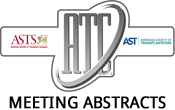2017 American Transplant Congress
Optimization of Pancreatic Islet-Like Clusters from hiPSCs for Cell Therapy in Type 1 Diabetes.
Surgery, Beth Israel Deaconess Medical Center, Boston, MA
IntroductionTreatment for Type 1 Diabetes (T1D) includes pancreas or islets of Langerhans transplantation. Pancreatic beta-like cells from differentiated human induced pluripotent stem cells (hiPSCs) offer…2017 American Transplant Congress
Mycophenolic Acid Needs Ca2+ to Exert Its Anti-inflammatory Action via Shedding of Toll-Like Receptor4 and Tumor Necrosis Factor Receptor 1.
Background Mycophenolic acid (MPA) has been used for many years to prevent transplantation rejection. Recently, it has been investigated for its anti-inflammatory effects. MPA can…2017 American Transplant Congress
Role of Protease Activated Receptor 1 and Sphingosine-1-Phospate Receptor 1 in Mice Hepatic Ischemia-Reperfusion Injury for Targeting Cell Signal Pathways of Activated Protein C.
Introduction: Hepatic ischemia-reperfusion injury (IRI) is a serious comlication during liver surgery. As for therapeutic strategies on hepatic IRI, we previously demonstrated that activated protein…2017 American Transplant Congress
Protective Effects of Bryostatin-1 on Neutrophil Migration in an In Vitro Model of Ischemia Reperfusion Injury: Impact for Therapy.
Background: Ischemia-reperfusion injury (IRI) is an inherent component of solid organ transplantation and axiomatically linked to graft damage. In the kidney, IRI results in a…2017 American Transplant Congress
Apoptotic Exosome-Like Vesicles Released During Tissue Injury Trigger IL23/IL-17 Autoimmune Axis and Accelerate Rejection.
Autoantibodies to apoptotic antigens, such as perlecan/LG3, are present pre-transplantation and contribute to organ rejection. We previously showed that during tissue injury, apoptotic endothelial cells…2017 American Transplant Congress
TGF-β1 Induces Transplant Kidney Interstitial Fibrosis Through Endothelial-to-Mesenchymal Transition via TGF-β/Smad and Akt/mTOR/p70S6K Pathways.
Urology, The First Affiliated Hospital of Nanjing Medical University, Nanjing, Jiangsu, China
Background: Chronic allograft dysfunction (CAD) induced by kidney interstitial fibrosis is the main cause of allograft failure in kidney transplantation. Studies suggested that endothelial-to-mesenchymal transition…2017 American Transplant Congress
Modification of Human Endothelial Cells by CRISPR/Cas9-Mediated Ablation of Class I and II Major Histocompatibility Complex Antigen Expression.
Yale School of Medicine, New Haven, CT
Human endothelial cells (ECs) derived from cord blood progenitors have significant replicative potential and are thus well suited for use in tissue engineering of vascularized…2017 American Transplant Congress
Uptake of Extracellular Mitochondria Activates Human Endothelial Cells That Stimulate Alloreactive Effector T Cell Responses.
1Surgery, Duke University, Durham, NC; 2Immunology, Duke University, Durham, NC
Introduction: Vascular endothelial cells (VECs), the initial barrier between host immunity and donor allograft tissue, play a critical role in allograft rejection. We investigated the…2017 American Transplant Congress
Effects of Anti-HLA Antibodies on Endothelial Expression and Serum Levels of Thrombomodulin in Kidney Recipients.
Medicine, Universite Laval, Quebec, QC, Canada
Background: Thrombomodulin (TBM) is an anticoagulant and anti-inflammatory protein expressed on endothelial cells (ECs). Mutations of TBM are seen in thrombotic microangiopathies due to aHUS.…2017 American Transplant Congress
Thrombalexin: Use of a Cytotopic Anticoagulant to Reduce Thrombotic Microangiopathy in a Highly Sensitized Model of Kidney Transplantation.
Introduction:Thrombotic microangiopathy (TMA) is a phenomenon observed in antibody-mediated rejection (AMR) of the kidney transplant, particularly in highly sensitized individuals. Following promising data in a…
- « Previous Page
- 1
- …
- 12
- 13
- 14
- 15
- 16
- …
- 18
- Next Page »
